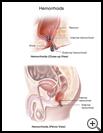
Hemorrhoid Banding
________________________________________________________________________
KEY POINTS
- Hemorrhoid banding is a way to remove hemorrhoids by putting tight bands around the swollen veins in the lower rectum and anus.
- Your healthcare provider may recommend banding if your hemorrhoids are bothering you and not responding to other treatments.
- Ask your provider how long it will take to recover and how to take care of yourself at home.
- Make sure you know what symptoms or problems you should watch for and what to do if you have them.
________________________________________________________________________
What is hemorrhoid banding?
Hemorrhoid banding is a way to remove hemorrhoids by putting tight bands around the swollen veins in the lower rectum and anus. The anus is the opening where bowel movements pass out of your body. The rectum is the end of the intestines just inside the anus. Hemorrhoids often cause pain, bleeding, and itching.
When is it used?
Your healthcare provider may recommend banding if your hemorrhoids are bothering you and not responding to other treatments.
Ask your provider about your choices for treatment and the risks.
How do I prepare for this procedure?
- Make plans for your care and recovery after you have the procedure. Find someone to give you a ride home after the procedure. Allow for time to rest and try to find other people to help with your day-to-day tasks while you recover the day of the procedure.
- You may or may not need to take your regular medicines the day of the procedure. Tell your healthcare provider about all medicines and supplements that you take. Some products may increase your risk of side effects. Ask your healthcare provider if you need to avoid taking any medicine or supplements before or after the procedure, especially any blood thinners or nonsteroidal anti-inflammatory medicines (NSAIDs), such as ibuprofen, naproxen, and aspirin.
- Tell your healthcare provider if you have any food, medicine, or other allergies such as latex.
- Follow any instructions your healthcare provider may give you.
- Ask any questions you have before the procedure. You should understand what your healthcare provider is going to do. You have the right to make decisions about your healthcare and to give permission for any tests or procedures.
What happens during the procedure?
This procedure may be done at your healthcare provider’s office or an outpatient clinic.
You may not need any anesthesia, or you may be given a local anesthetic to numb the area and keep you from feeling pain.
Your healthcare provider will put a short, lighted tube called an anoscope into your rectum. Your provider will use the scope to see the hemorrhoids and put 1 or 2 tiny rubber bands around the base of each hemorrhoid. The bands cut off blood flow to the hemorrhoids. The lack of blood flow will cause the hemorrhoids to dry up and fall off in 1 to 2 weeks. Your provider may also cut the hemorrhoids open and remove any blood clots.
What happens after the procedure?
You can go home after the procedure.
You may have light bleeding for a few days. The banded areas usually take about 2 weeks to heal completely. As the area heals, the hemorrhoids shrink and dry up and will pass out of your body with bowel movements.
You may have trouble controlling gas and bowel movements for a few days after this procedure due to swelling in the area around the banded hemorrhoids. You may have a feeling of fullness in your lower belly, or you may feel like you need to have a bowel movement.
Most of the time, pain or other discomfort after the procedure is mild. Your healthcare provider can prescribe pain medicine if you need it.
Your healthcare provider may recommend the following to care for yourself as you recover:
- Take sitz baths by sitting in a bathtub of warm water for 15 to 20 minutes. This helps keep the area clean and increases blood flow to the area to help healing. Ask your provider how often you should do this.
- Ask your provider about ointments to put on the anal area.
- Use a “donut” pillow if needed to help you sit more comfortably for the first few days after surgery.
It’s important to eat a healthy diet, but try to avoid foods that might cause constipation or diarrhea while you are healing. Ask your healthcare provider which foods you should eat and avoid while you recover. If diet and extra fluids are not enough to avoid constipation, your provider may recommend a stool softener or laxative.
Ask your provider:
- How long it will take to recover
- If there are activities you should avoid and when you can return to your normal activities
- How to take care of yourself at home
- What symptoms or problems you should watch for and what to do if you have them
Make sure you know when you should come back for a checkup. You may need several treatments. Keep all appointments for provider visits or tests.
What are the risks of this procedure?
Every procedure or treatment has risks. Some possible risks of this procedure include:
- You may have problems with anesthesia.
- You may have infection or bleeding.
- You may have trouble urinating for a day or two.
Ask your healthcare provider how the risks apply to you. Be sure to discuss any other questions or concerns that you may have.

